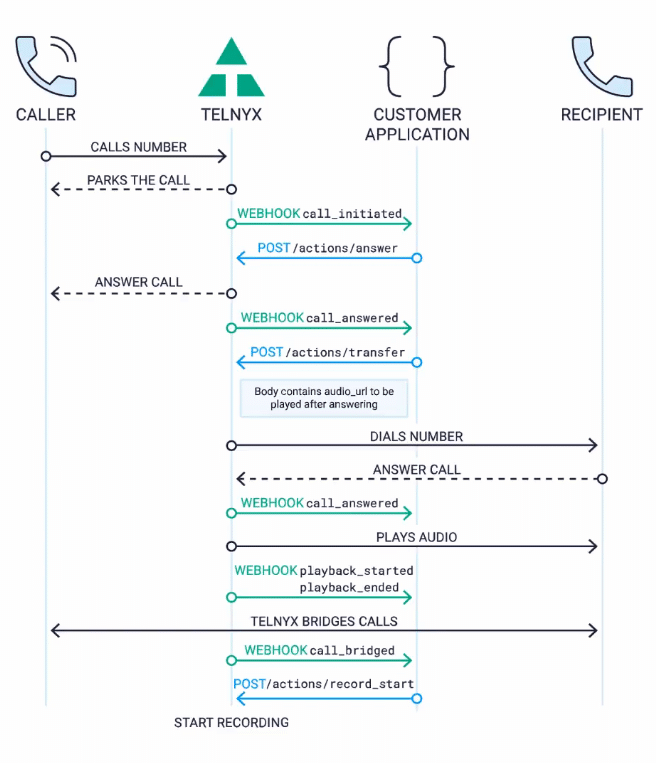Blog > Telnyx Call Control

What is Call Control:
Call Control is a programmable voice API. For instance, when a user contacts a call center, they encounter a recorded menu offering options such as pressing one for sales or support and two for agent support. Selecting agent support automatically transfers the user’s call to the appropriate department based on their selection. Telnyx enhances this experience with its advanced Call Control API.
Telnyx Call Control:
Many companies use embedded voice calling to make collaboration easy, but building and maintaining a voice application from scratch is complicated. It distracts developers from working on the core components for their solutions; that’s why developers turn to Telnyx rather than others. The Telnyx Call Control API allows users to incorporate voice workflows quickly within their applications. Their programmatic Call Control allows developers the building blocks to create customizable caller experiences.
A simple set of Call Control API commands controls the Telnyx communication engine, which returns webhook notifications to users’ systems. For example, you can build branching interactive voice response workflows from a single command.
When the user system sends a command, the Telnyx system begins monitoring for dial-tone responses. Each response will be forwarded to the user system as a webhook notification. The logic for administering the call is built into the application using Telnyx commands; they make the workflow responsive and sophisticated according to user requirements.
How Telnyx Call Control Different:
Telnyx Call Control provides its users total control over the call via API, whether you’re transferring, forking media for real-time audio processing, conferencing in several users, or enabling/disabling recording on the fly. Call Control allows you to embed customized communications workflows into your application.
Telnyx provides advanced features such as:
- Answering Machine Detection
- Call Conferencing
- Media Forking
The above features show how data packets are transferred across the network and granular into the call flow. All the features mentioned above can be used by Telnyx out–off–the–box call control API.
API and Call Flow Control
Telnyx is one of the largest interconnected VoIP carriers companies in the country. Its call control system design makes it easier to embed voice capabilities and add advanced features like conferencing, call recording, and text-to-speech into the software application with a lot more to come. Telnyx Call Control system brings advanced functionalities.
In addition, the advantage of leveraging the Call Control API is that application developers don’t need Telecom’s domain expertise to build great voice applications. It can be used to develop call center applications, call tracking apps, voice dialers, or even work for the staff.

Telnyx Programmatic Call Control Commands
Moreover, Call Control API offers the developer a handful of commands for some actions like answering an incoming call, dial a new call, or bridging an existing call; there is a webhook associated with each of these commands.

Building IVR with Call Control
Call center applications, call tracking apps, voice dialers, or workforce apps with embedded collaboration can leverage a Call Control API to build highly customizable caller experiences.
Indeed, a developer could build a widespread application called an interactive voice response system. Telnyx provides different Call Control solutions and commands. Moreover, Telnyx Telephony is a new infrastructure that defines network interface, network backbone, and phone numbers.
Call Control: Carrier vs. Non-Carrier
| Carrier | Non-Carrier |
| Licensed as an interconnected VOIP carrier | Application business that manages pass-through traffic |
| Manages a private network environment | Reliant on the public internet for connectivity |
| Tier-1 privileges from PSTN operators and owned phone number assets and routing control | Partners with telecom aggregators for communications functionality and numbers |
Carrier: Carrier refers to a licensed company that operates on the same footing and with the same regulatory privileges as other traditional telephone companies. So, these companies typically manage their private network, and have direct interconnection and privileges with one PSTN operator. Therefore, these companies own their numbering assets and routing infrastructure.
Non-Carrier: However, Non-Carrier focuses on developing those APIs, better developer experience, call delivery, and providing numbers.
Author: SVCIT Editorial
Copyright Silicon Valley Cloud IT, LLC.